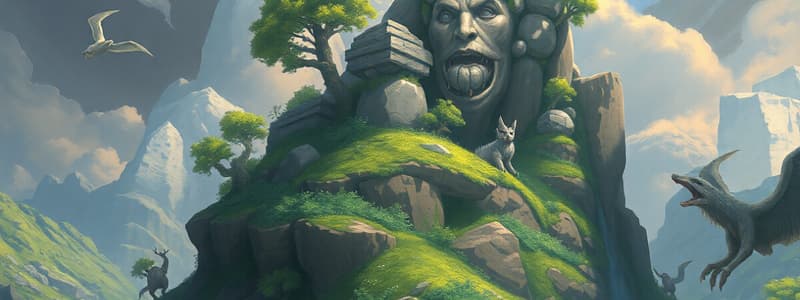Podcast
Questions and Answers
Which characteristic of living things is primarily responsible for the generation of energy from food?
Which characteristic of living things is primarily responsible for the generation of energy from food?
- Reproduction
- Metabolism (correct)
- Growth
- Homeostasis
What is the primary function of structural adaptations in organisms?
What is the primary function of structural adaptations in organisms?
- To ensure reproduction
- To assist in survival through physical features (correct)
- To react to environmental stimuli
- To control internal body processes
In the context of classification, which kingdom do unicellular organisms such as bacteria belong to?
In the context of classification, which kingdom do unicellular organisms such as bacteria belong to?
- Animals
- Fungi
- Monera (correct)
- Protists
Which process describes the change from a caterpillar to a butterfly?
Which process describes the change from a caterpillar to a butterfly?
Which type of adaptation involves migration as a survival strategy?
Which type of adaptation involves migration as a survival strategy?
What is meant by homeostasis in living organisms?
What is meant by homeostasis in living organisms?
Which group of organisms includes both multicellular and unicellular decomposers?
Which group of organisms includes both multicellular and unicellular decomposers?
What key role do producers play in an ecosystem?
What key role do producers play in an ecosystem?
Flashcards are hidden until you start studying
Study Notes
Characteristics of Living Things
- Cells: All living things are made of cells.
- Reproduction: Ability to reproduce, either sexually or asexually.
- Metabolism: Chemical processes for converting food into energy.
- Growth: Living organisms undergo growth and development.
- Response to Stimuli: React to environmental changes (e.g., light, temperature).
- Homeostasis: Maintain stable internal conditions (e.g., temperature, pH).
- Adaptation: Evolve and adapt to their environment over time.
Classification of Living Things
- Five Kingdoms:
- Animals: Multicellular, heterotrophic organisms.
- Plants: Multicellular, autotrophic organisms that photosynthesize.
- Fungi: Multicellular or unicellular, decomposers, non-photosynthetic.
- Protists: Mostly unicellular organisms, some multicellular.
- Monera: Unicellular organisms, including bacteria.
Habitat and Ecosystems
- Habitat: The environment where an organism lives.
- Ecosystem: A community of living organisms interacting with their environment.
- Food Chains and Webs:
- Producers: Plants that convert sunlight into energy.
- Consumers: Animals that eat plants or other animals.
- Decomposers: Organisms that break down dead matter.
Adaptations
- Structural Adaptations: Physical features (e.g., shape, color).
- Behavioral Adaptations: Actions that help survive (e.g., migration).
- Physiological Adaptations: Internal body processes (e.g., temperature regulation).
Life Cycles
- Metamorphosis: Developmental changes (e.g., caterpillar to butterfly).
- Gestation: The period of development inside a mother.
- Reproductive Strategies: Ways organisms ensure survival of offspring.
Interdependence
- Symbiosis: Interaction between different organisms (e.g., mutualism, commensalism, parasitism).
- Food Relationships: How organisms support each other within ecosystems.
Conservation and Biodiversity
- Importance of preserving habitats and species.
- Impact of human activities on ecosystems (e.g., pollution, deforestation).
- Efforts to maintain biodiversity and protect endangered species.
Studying That Suits You
Use AI to generate personalized quizzes and flashcards to suit your learning preferences.



